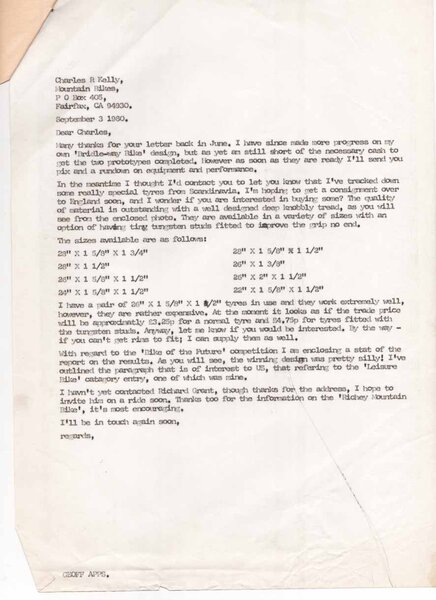- Feedback
- View
Watch this video in which Gary Fisher explains that he had the idea for a big wheeled mountain bike back in 1979 but it took until the late 1990's to make the idea a reality.
http://www.youtube.com/watch?v=n7xNohTerzU&feature=plcp
Then read the letter below to Charlie Kelly, Gary Fisher's business partner at The MountainBikes company. It is from Geoff Apps and dated September 1980.
In the letter is offering to supply Finnish snow tyres to Kelly and Fisher.
28"x 1"5/8 x 1"3/4 are the same as modern of 700C x 47mm.
28"x 1"5/8 x 1"1/2 are even bigger diameter at 700B x 44mm
Whilst 26 x 2" x 1"1/2 are equivalent to modern 650B x 54mm
Over the next four years Apps supplied many oversize tyres to Fisher and Kelly and bikes many were built to use them. They proved successful in both cyclo-cross and mountain bike races. One Marin framebuilder who made bikes to fit the Apps supplied tyres was Ross Schafer. Schafer had his Salsa Cycles workshop in Crested Butte, next door to Bruce Gordon's workshop.
Only the high costs of importing these tyres combined with the erratic supplies from Finland stopped one of these bigger tyre sizes from becoming the standard for early mountain bikes.
In 1988 with the support of MTB pioneer Joe Murray, Bruce Gordon copied the tread pattern of the 700c x 47mm Hakkapeliitta tyres and had copies manufactured by Cheng Shin. They were narrower at 40mm wide and were marketed as the "Rock n' Road" tire. They were fitted to bikes especially made by Bruce Gordon and Wes Williams. This sorted out the supply issues with the tyres from Finland but by then the smaller and readily available 26" wheels were firmly established as the norm.
Ten years later in 1998 Gary Fisher and Wes Williams were the two key movers who persuading WTB to produce the NanoRaptor 700C x 52mm tyre. Which later became known as the first 29er tyre despite the fact that there overall diameter of 28.6 inches was slightly less than 29"
One of the "two prototypes" that Apps refers to in his letter was built as a Range-Rider bicycle in 1981 using 700C x 47mm Hakkapeliitta tyres. Thus this Cleland style off-road bicycle preempted the the birth of the 29ers by 20 years.
Unfortunately in Britain, manufacturers did not take Apps' ideas seriously. Preferring to copy the smaller wheeled American designed bikes instead.
Later in the 1980's, David Wrath-Sharmans avocation of bigger wheeled off-road bikes was also ignored.
http://www.youtube.com/watch?v=n7xNohTerzU&feature=plcp
Then read the letter below to Charlie Kelly, Gary Fisher's business partner at The MountainBikes company. It is from Geoff Apps and dated September 1980.
In the letter is offering to supply Finnish snow tyres to Kelly and Fisher.
28"x 1"5/8 x 1"3/4 are the same as modern of 700C x 47mm.
28"x 1"5/8 x 1"1/2 are even bigger diameter at 700B x 44mm
Whilst 26 x 2" x 1"1/2 are equivalent to modern 650B x 54mm
Over the next four years Apps supplied many oversize tyres to Fisher and Kelly and bikes many were built to use them. They proved successful in both cyclo-cross and mountain bike races. One Marin framebuilder who made bikes to fit the Apps supplied tyres was Ross Schafer. Schafer had his Salsa Cycles workshop in Crested Butte, next door to Bruce Gordon's workshop.
Only the high costs of importing these tyres combined with the erratic supplies from Finland stopped one of these bigger tyre sizes from becoming the standard for early mountain bikes.
In 1988 with the support of MTB pioneer Joe Murray, Bruce Gordon copied the tread pattern of the 700c x 47mm Hakkapeliitta tyres and had copies manufactured by Cheng Shin. They were narrower at 40mm wide and were marketed as the "Rock n' Road" tire. They were fitted to bikes especially made by Bruce Gordon and Wes Williams. This sorted out the supply issues with the tyres from Finland but by then the smaller and readily available 26" wheels were firmly established as the norm.
Ten years later in 1998 Gary Fisher and Wes Williams were the two key movers who persuading WTB to produce the NanoRaptor 700C x 52mm tyre. Which later became known as the first 29er tyre despite the fact that there overall diameter of 28.6 inches was slightly less than 29"
One of the "two prototypes" that Apps refers to in his letter was built as a Range-Rider bicycle in 1981 using 700C x 47mm Hakkapeliitta tyres. Thus this Cleland style off-road bicycle preempted the the birth of the 29ers by 20 years.
Unfortunately in Britain, manufacturers did not take Apps' ideas seriously. Preferring to copy the smaller wheeled American designed bikes instead.
Later in the 1980's, David Wrath-Sharmans avocation of bigger wheeled off-road bikes was also ignored.
